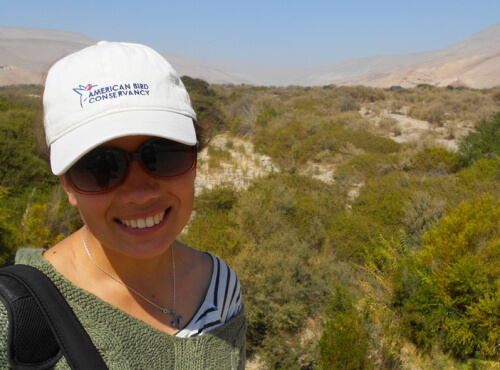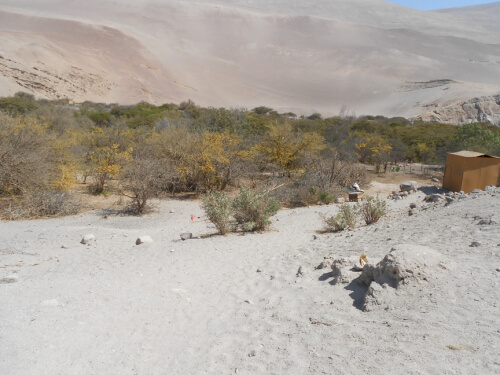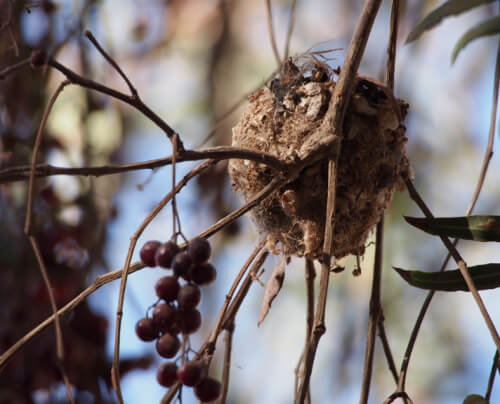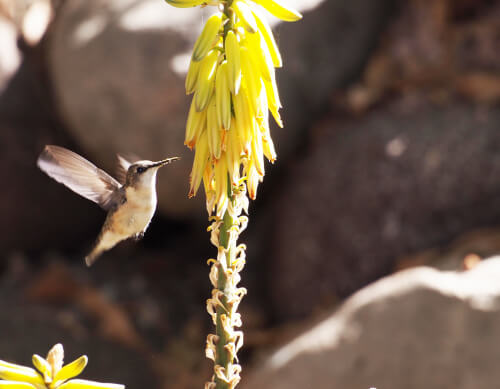Chilean Woodstar: A Species Clings to Life in an Otherworldly Landscape

The Chilean Woodstar has declined by 80 percent over the last decade. I visited Chile recently to explore how to prevent this species' extinction. Photo by Jorge Herreros.
By Dan Lebbin
Departing the city of Arica, Chile, during predawn hours, Bojana Kuzimicic picks me up in a Suburu Forester SUV and we drive out into the desert. Our first destination is Taltape, in the Camarones Valley, a two hours' drive south of Arica.
This desert, the Atacama, looks very much like images sent back to Earth from robots roving the surface of Mars. Not a single plant is visible among the soft sandy plains and mountains dotted with rocks, stretching as far as the eye can see in all directions. The color palate is otherworldly as well, featuring grays, taupes, and orange-reds. The highway and bright blue sky serve as reminders that we are still on Earth.

Bojana Kuzimicic, coordinator for the Chilean Woodstar project, led me on a tour of efforts to conserve one of Chile's most threatened birds. In the background is the Chaca Reserve, where Bojana is working with other researchers and AvesChile to restore native vegetation. Photo by Dan Lebbin.
Bojana is a graduate student at the University of Chile, working with Cristian Estades and bird conservation group AvesChile to study and conserve the Chilean Woodstar, perhaps Chile's most threatened bird. ABC is supporting this work thanks to a grant from the Mohamed bin Zayed Species Conservation Fund.
Going, Going … Not Quite Gone
Several canyons bisect this desert, formed by seasonal streams that run east to west from the High Andes to the Pacific Ocean. At the bottom of these Martian-like gorges, the flow of water supports modest vegetation within a narrow floodplain. Here, bushes, grasses, and horsetails sprout, and larger chañar bushes with small yellow flowers and acacia trees grow along the banks.

We pass through Martian-like landscapes, including this one in the Camarones Valley, on our way to the Chaca Reserve. Photo by Dan Lebbin.
The Chilean Woodstar was once found in these desert river valleys but has only been seen in remnant habitat patches during the last decade. During that time, the population has declined by more than 80 percent, from at least 1,500 birds in 2003 to roughly 400 birds in 2012. This decline started in the 1960s when pesticides (now discontinued) to control fruit flies were widely used. The species' dramatic decline led ABC and partner group AvesChile to petition for the bird's uplisting from Endangered to Critically Endangered by the International Union for Conservation of Nature (IUCN).
While these meager oases provide habitat for birds, they also provide opportunities for farmers. Much of the vegetated habitat in these canyons has been converted to farm fields growing corn, onions, tomatoes, and olives. Most of the Chilean Woodstar's natural habitat has been converted or heavily degraded in this way, and the species now relies on a mix of native and non-native plants for feeding and nesting.
In addition, the closely related Peruvian Sheartail, which competes and hybridizes with the Chilean Woodstar, has expanded its range from Peru into these areas of Chile and now outnumbers Chilean Woodstars. The woodstar may be disappearing most rapidly from areas where the alien sheartails have invaded.
The Search for Life
As we travel across the desert, we turn off the main highway to drive west into the Camarones Valley, named after the prawns that can found in its river. Early morning fog rolls up the valley from the coast, obscuring signs of life below. We descend on a dirt road, like a spaceship penetrating the atmosphere of an inhospitable planet.

We descend on a dirt road through the fog, like spaceship penetrating the atmosphere of an inhospitable planet. Photo by Dan Lebbin.
When we arrive at Taltape, we stop at a section of the river to start searching for Chilean Woodstars. Bojana says that males were defending territories here a few months ago, but since then, bulldozers have cleared the vegetation along the bank in preparation to plant crops. The smell of charcoal and blackened sand also reveals the use of recent fires to help clear debris in preparation for planting. We do not find any hummingbirds here.
Continuing up the valley, we stop at a rustic farm house surrounded by Peruvian pepper trees. In previous years, multiple Chilean Woodstars nested among the branches of these trees, which hang like weeping willows. Bojana shows me two nests within a few feet of each other in one tree, and a third in another. We then walk alfalfa fields and gravel bars in the river searching for Chilean Woodstars with no luck.
Back at the farm house, I suddenly hear the monotonous chatter of a hummingbird near some agaves with yellow flowers. Soon, two female Chilean Woodstars appear and alternately feed on yellow aloe flowers and white flowers of a nearby tree. Although male Chilean Woodstars have violet and blue throats and an elongated tail, female Chilean Woodstars are much more muted in color.
A Decisive Moment for the Woodstar
AvesChile is working to create a small reserve here in the Taltape Valley to protect and restore habitat for the woodstar, and they have already established a small reserve at Chaca in the Vitor Valley, about 40 minutes away by car from Arica. This is our next stop.

Chile's Vitor Valley, where researchers are studying how to best restore vegetation for the Chilean Woodstar.
Here, Cristian, Bojana, and colleagues have established experimental plots to study which soil and irrigation treatments are most effective for restoring native vegetation and flowering plants for the species. Red flags mark a partially completed trail, and beige shacks with locked doors house water tanks to irrigate the restoration plots.
Despite its small size, water runs in the stream through the Chaca Reserve, and it is full of life. Both the Oasis Hummingbird and Chilean Woodstar occur here, and songbirds like the Plain-mantled Tit-Spinetail, Cinereous Conebill, and Slender-billed Finch flit among the bushes.
Much more needs to be done to ensure that habitat for Chilean Woodstars is protected and restored, to halt this hummingbird's decline and possible extinction. While in Chile, I had many conversations with Chilean government officials and AvesChile project personnel about future actions. In the next few months, government, NGO, business, agriculture, and other stakeholders will gather to identify the important next steps in conserving this species and will hopefully begin to act quickly.
ABC, AvesChile, and Chilean government officials would like to see a network of reserves established throughout the woodstar's range—carefully managed to improve habitat quality for the species. AvesChile's work at Chaca is just beginning to investigate how to accomplish this.
How will the story end? Either Chileans will be successful and begin to recover the Chilean Woodstar population before it is too late, or the world will lose a remarkably beautiful bird to extinction. We have much work to do to ensure a future for this bird.
Editor's Note: ABC is currently seeking funding to expand our work with AvesChile to establish a network of small reserves where we can restore and manage habitat for the Chilean Woodstar, experiment with Peruvian Sheartail removal, conduct public outreach to reduce pesticide usage—and ultimately prevent the extinction of this species. Please consider supporting this important work with a donation to American Bird Conservancy.
 Dan Lebbin is a Conservation Biologist with American Bird Conservancy. A birder since childhood, Daniel also enjoys bird illustration and photography, and his images appear in a variety of publications.
Dan Lebbin is a Conservation Biologist with American Bird Conservancy. A birder since childhood, Daniel also enjoys bird illustration and photography, and his images appear in a variety of publications.




















































